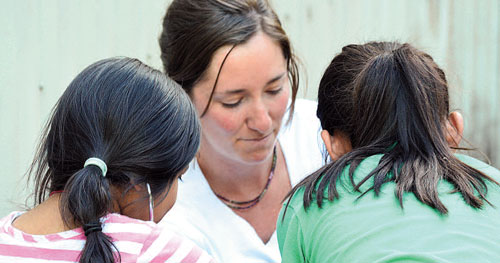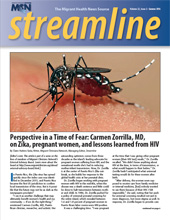Steps to Health: Community Health Workers and Diabetic Patients in Oregon’s Columbia Gorge

Claire Hutkins Seda, Writer, Migrant Clinicians Network, Managing Editor, Streamline
The mid-Columbia agricultural region, in Oregon’s Columbia River Gorge, produces some of the West Coast’s tastiest cherries, pears, and apples. It’s also home to thousands of seasonal agricultural workers who tend those orchards. One Community Health (OCH), previously known as La Clinica del Cariño, has taken a community-forward approach to caring for the health needs of these workers, by investing in and fortifying its community health worker (CHW) programs, and assuring a close and vibrant working relationship between CHWs and providers. According to Brooke Nicholls, RN, FNP, a manager of several of OCH’s CHW programs, the years of investment have paid off.
“Our community health workers recruit participants [for our classes] and engage them in a way that we as providers cannot,” Nicholls noted. All of the CHW programs fall under OCH’s enabling services department, with the goal to address the social determinants of health of the community. Within that department, OCH offers Salud (“Health”), an in-clinic diabetes care management program in which patients work with CHWs, and Pasos Hacia Salud (“Steps Toward Health”), a community-based diabetes education program that is open to the public. Both have been operating for years, serving patients in Hood River and surrounding communities.
On a late May morning, Evaristo Romero, a long-time CHW in the Salud program, was on his way to an appointment with one of those patients. It was the first week of the cherry season, marking the start of the busy time of year for Romero, who assists 150 patients between June and September. The patient, a diabetic, had seen Romero for four or five years, but Romero already knew her for years prior, when they were both agricultural workers. Romero recalled, “We were picking cherries occasionally together. I remember being in the same orchard, my family and her family.” Such personal connections help keep patients motivated to stay connected with the clinic, and to stay on track with their treatment plans. The patient’s appointment with Romero was before her exam with her provider. Together, Romero and the patient would review her medications and take blood pressure readings. “I take important notes for the provider that maybe the patient will tell me — like ‘I’ve stopped taking my medication for the last month’ — that will explain to the provider why the patient has elevated blood sugar levels,” he said. This could be critical information that in the short window of time with the provider, the patient may not be able or feel comfortable to express.
The pre-provider-visit appointment is just one type of encounter that Romero has with his patients. Often, the patient will have a 15-minute provider appointment, followed by an hour-long appointment with Romero or another Salud CHW. Again, the added time is essential to strengthening the patient relationship. “We don’t meet with our patients and immediately talk about their medication. We [ask], how is the family doing? How are the cherries doing this year?” Romero explains. “It helps them feel at ease, comfortable.”
The patient’s care team communicates in person and through the electronic medical record (EMR). Romero’s nurse supervisor, a certified diabetes educator who oversees several CHWs, reviews Romero’s notes in a patient’s EMR, discusses the patient with the provider if necessary, and makes recommendations to the patient’s provider. Often, Romero said, he will get a call from a patient’s provider who has decided to adjust a patient’s medication based on the CHW appointment’s findings. Romero contacts the patient to help the patient understand the medication changes and the reasoning behind the change. “We are engaging them in the management” of their own health, empowering them to stay involved, Romero said, which greatly enhances a patient’s ability to stay on track.
The Salud program is just one of many programs targeting diabetic or pre-diabetic, hypertensive, and/or obese agricultural workers at OCH. In partnership with the Oregon Health & Science University’s Casey Eye Institute, OCH offers the Casey Eye van, in which they provide dilated eye exams to screen for diabetic retinopathy, right at the clinic. Providers who are seeing patients will note on the EMR that they haven’t had a diabetes eye exam and that they aren’t insured, flagging them for an appointment for the Casey Eye Van, Nicholls explained. The van arrives on a Saturday, with the needed specialized equipment, ophthalmologist and other specialists, and additionalvolunteer staff. OCH provides the clinic for additional space and equipment, and its own staff. Roughly 40 people are treated during one day with the van, “and we have a waiting list,” noted Nicholls.
A third diabetes-specific CHW program goes beyond the walls of the clinic. Pasos Hacia Salud, a 12-week class for diabetics or people at risk for developing diabetes, focuses on exercise, healthy eating, and stress for its 20 to 30 participants. The classes are a collaboration between OCH and The Next Door, Inc., along with support from many other community members. It is open to the public, not just patients at OCH. But to maintain its astounding graduation rate of over 85 percent, CHW Alicia Sandoval, who runs the Pasos classes, gives a lot of care to the recruitment process, assuring that community members who choose to be participants in the classes are ready and motivated.
At each class, “we work to keep up the motivation, but at the same time, we make sure the participants are comfortable… We make sure we give participants the opportunity to participate by providing a class format that’s really simple,” said Sandoval, who noted that they utilize a popular education model to deliver their educational goals in ways appropriate for participants who may not read or write. They are happy to meet the participants where they are, she says: “It’s very important to provide support for every participant, because every participant comes with different needs.” The popular education model, careful recruitment of participants, and individual attention are augmented with prizes, communal meals, and fun classes like Zumba, which results in high graduation rates. Sandoval’s most recent class, which wrapped up in May, featured 28 graduates from an initially recruited group of 31.
Pasos is offered regularly through the year in Spanish, and presented every two years in English. The courses began with grant funding through the National Institutes of Health. After three grant cycles, OCH decided to become the primary funder of the courses, and community partners stepped in to help offset the costs. The early grant funding allowed the clinic to pilot the program for several cycles, allowing executive staff to test out its usefulness for the community and its effect on health. This is the first year that Pasos is not grant funded; Nicholls estimates that with costs like staff time, guest instructors and specialists, and supply costs like food, the cost will be roughly $12,000 per class. Now, Nicholls is working to measure outcomes to determine the impact to the community per dollar spent. So far, the data are encouraging. “Nearly all participants (>90%) have reported healthier habits post-class: more physical activity, more fruit and vegetable consumption and less stress,” Nicholls reported. Participants’ body-mass measurements showed a majority losing weight or at least maintaining their weight after the class. “Some participants [lost] as much as 10 percent of their body weight and [maintained] that at a six-month follow-up,” Nicholls said.
Outside of the data, Nicholls sees a healthier community. Participants often maintain relationships with their fellow graduates, to keep up healthy lifestyles through activities like walking groups, or just to stay in touch with friends made through Pasos Hacia Salud. “Pasos has been an incredible asset to our clinic and the community, empowering so many folks to take charge of their own health,” Nicholls stated. “Our community health workers recruit participants and engage them in a way that we as providers cannot...They’ve lost weight and lowered their blood sugars, but, more importantly, they’ve adopted healthy habits that will improve their overall quality of life, and [they’ve] made friends and a support group in the process. Pasos is about bringing health and community together!”
Read this article in the Summer 2016 issue of Streamline here!
Sign up for our eNewsletter to receive bimonthly news from MCN, including announcements of the next Streamline.
Return to the Streamline Summer 2016 Table of Contents.
